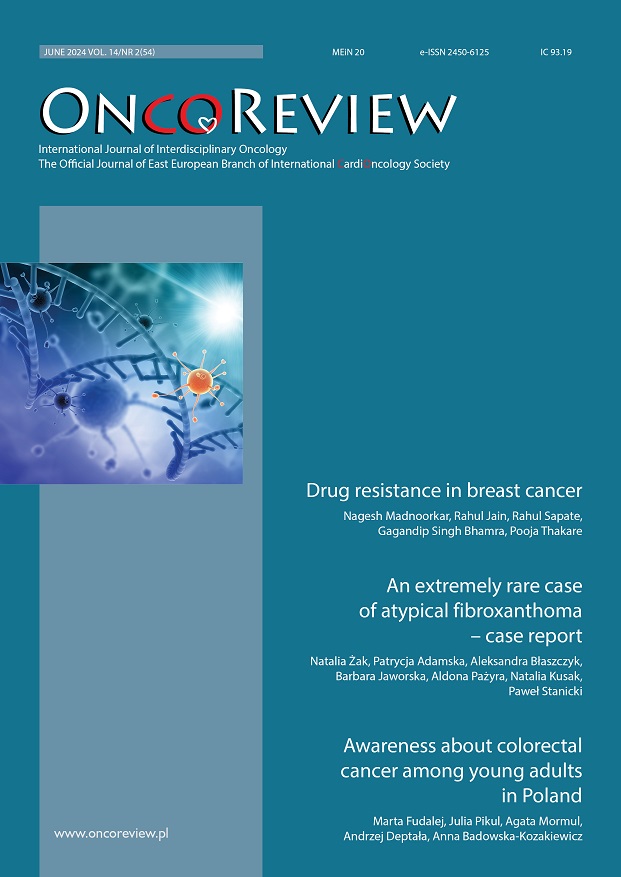Drug resistance in breast cancer Review article
Main Article Content
Abstract
Objective: The obstacle of resistance throughout breast cancer treatment leads to failure of therapy and progress in the disease. Current developments in our knowledge of the molecular pathways behind resistance to therapies in breast cancer will be covered in this brief review.
Materials and methods: The presented data in this review is gathered from multiple sources such as clinical observations (information about how patients react to systemic treatments), experimental models (data gathered from in vitro and in vivo drug resistance simulation framework), review of genetic alterations and epigenetic changes that contribute to resistance is done through genomic and epigenetic studies. The drug resistance mechanisms: target mutations, novel signaling pathways, modifications to the tumor microenvironment, emerging biomarkers, genetic and epigenetic modifications (targeted gene mutations, modifications in drug transporter expression, activation of signaling pathways).
Conclusion: Ongoing investigations are essential for identifying successful approaches to combat drug resistance in breast cancer. The process of refinement of combining medicines, development of novel targeted treatments, and research into mechanisms that limit drug transport are among the areas of focus.
Downloads
Metrics
Article Details

This work is licensed under a Creative Commons Attribution-NonCommercial 4.0 International License.
Copyright: © Medical Education sp. z o.o. This is an Open Access article distributed under the terms of the Attribution-NonCommercial 4.0 International (CC BY-NC 4.0). License (https://creativecommons.org/licenses/by-nc/4.0/), allowing third parties to copy and redistribute the material in any medium or format and to remix, transform, and build upon the material, provided the original work is properly cited and states its license.
Address reprint requests to: Medical Education, Marcin Kuźma (marcin.kuzma@mededu.pl)
References
2. Wu Q, Ba-Alawi W, Deblois G et al. GLUT1 inhibition blocks growth of RB1-positive triple negative breast cancer. Nat Commun. 2020; 11(1): 4205.
3. Piwnica-Worms D. Elucidating mechanisms of farnesyltransferase inhibitor action and resistance in breast cancer by bioluminescence imaging. (2010). https://doi.org/10.21236/ada540951.
4. Thompso D. Testing if the SonoTran platform can enhance drug delivery in metastatic colorectal cancer. (2021). https://doi.org/10.1186/isrctn17598292.
5. Mesker W. Chemotherapy or Not? Practice-Changing Approach for the Accurate Selection of Patients for Chemotherapy Treatment after Colon Cancer Diagnosis. The Tumour-Stroma-Ratio (TSR) an Addition to the TNM Classification. (2017). https://doi.org/10.26226/morressier.596dfd59d462b8029238760d.
6. Luque-Bolivar A, Pérez-Mora E, Villegas VE et al. Resistance and overcoming resistance in breast cancer. Breast Cancer: Targets Ther. 2020; 12: 211-29.
7. Pradubyat N, Laoharuangchaiyot J. Molecular mechanisms of drug resistance in breast cancer and potential strategies for overcoming resistance. Oncología (Ecuador). 2023; 33: 1-17.
8. Bao X, Zheng W, Sugi NH et al. Small molecule schweinfurthins selectively inhibit cancer cell proliferation and mTOR/AKT signaling by interfering with trans-golgi-network trafficking. Cancer Biol Ther. 2015; 16(4): 589-601. http://doi.org/10.1080/15384047.2015.1019184.
9. Xu H, Li T, Gong Q et al. Genetic variations in the retrograde endocannabinoid signaling pathway in chinese patients with major depressive disorder. Front Neurol. 2023; 14: 1153509.
10. Kinnel B, Singh SK, Oprea-Ilies G, Singh R. Targeted Therapy and Mechanisms of Drug Resistance in Breast Cancer. Cancers (Basel). 2023; 15(4): 1320.
11. Pang RW, Poon RT. Clinical Implications of Angiogenesis in Cancers. Vasc Health Risk Manag. 2018; 2: 97-108.
12. Liu Y, Zheng C, Huang Y et al. Molecular Mechanisms of Chemo- and Radiotherapy Resistance and the Potential Implications for Cancer Treatment. MedComm. 2021; 2: 315-40.
13. Ni Y, Zhou X, Yang J et al. The Role of Tumor-Stroma Interactions in Drug Resistance within the Tumor Microenvironment. Front Cell Dev Biol. 2021; 9: 637675.
14. Miyoshi E, Morabito S, Swarup V. Systems Biology Approaches to Unravel the Molecular and Genetic Architecture of Alzheimer's Disease and Related Tauopathies. Neurobiol Dis. 2021; 160: 105530.
15. Xu H, Li T, Gong Q et al. Genetic Variations in the Retrograde Endocannabinoid Signaling Pathway in Chinese Patients with Major Depressive Disorder. Front Neurol. 2023; 14: 1153509.
16. Haber DA, Velculescu VE. Blood-Based Analyses of Cancer: Circulating Tumor Cells and Circulating Tumor DNA. Cancer Discovery. 2014; 4: 650-61.
17. Fiori ME, Di Franco S, Villanova L et al. Cancer-Associated Fibroblasts as Abettors of Tumor Progression at the Crossroads of EMT and Therapy Resistance. Mol Cancer. 2019; 18: 1-16.
18. Zhang N, Jiang J, Tang S et al. Predictive Value of Neutrophil-Lymphocyte Ratio and Platelet- Lymphocyte Ratio in Non-Small Cell Lung Cancer Patients Treated with Immune Checkpoint Inhibitors: A Meta-Analysis. Int Immunopharmacol. 2020; 85: 106677.
19. Li H, Yang Y, Hong W et al. Applications of Genome Editing Technology in the Targeted Therapy of Human Diseases: Mechanisms, Advances and Prospects. Signal Transduct. Target Ther. 2020; 5(1): 1.

